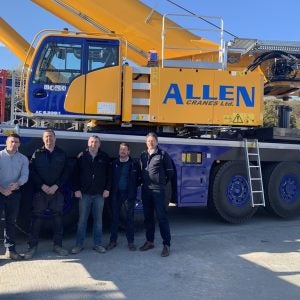The National Institute on Aging General Research Program Gerontology Research Center’s Laboratory of Clinical Investigation is moving three large, several-US ton magnets to a new building across the street.
The NAICS code for this solicitation is 238990 and the small business size standard is $13.0 million. This requirement is set-aside for small business. The period of performance is approximately 5 days and is to be scheduled the end of March, 2008.
Contact: Department of Health and Human Services, National Institutes of Health, National Institute on Aging, IRP, BRC, 251 Bayview Blvd, Room 04C009, Baltimore, MD, 21224, UNITED STATES
Patricia Meise, Purchasing Agent, Phone 410-558-8043, Fax 410-558-8319, Email meisep@grc.nia.nih.gov
Solicitation number: FAC82
The job in detail:
* Due to the sensitivity of the equipment, a knowledgeable contractor and means of effective communication shall be required to ensure the requirements are met. The Contract support teams must be skilled and precise in relocating large, sensitive MRI and NMR magnets. All NIH contracts shall be treated with the highest levels of professionalism especially when directly interacting with the Move Coordinator and NIH staff in the workplace as well as with researchers in the laboratories.
* Independently, and not as an agent of the Government, the Contractor shall furnish all labor, materials, vehicles, equipment, licenses, permits, insurances, subcontracts, management, expertise and other resources necessary to transport government owned property between the two locations.
The contractor must be able to schedule up to a month before the actual move and respond in a timely manner. The sequence of this move is dependent on several time sensitive factors that will be coordinated by the Move Coordinator and NIH.
1.4 Schedule Overview
Rigging services will commence once the Faraday cages for the ABX 1.9T/30 and 7T/30 instruments are in place and have been tested.
Unlike at the GRC, all three magnets will be relocated to an open floor plan and will all be housed in one room. A floor plan of the new layout will be provided.
Due to the existing location of the 7T/30 in the GRC building, a large crane will probably need to park on a Johns Hopkins emergency route on Nathan Shock Drive. To minimize disturbance to activities on the hospital campus, work will need to be performed early in the morning on a weekend. NIH will make the appropriate arrangements with Johns Hopkins security concerning road closures/detours. Johns Hopkins does not provide flaggers; this shall be provided by the contractor.
An up-to-date underground utilities plan for the roadway separating the BRC from the GRC and the roadway in front of ARC and NIDA will be provided to the Contractor in order to plan the location of heavy equipment so as not to endanger buried utilities.
SECTION 2
SCOPE OF WORK
2.1 Pre-Move:
* In cooperation with the Move coordinator and Lab Manager, the Contractor shall develop and submit a relocation plan.
* The Move Coordinator shall provide the confirmed schedule to the Contractor two weeks prior to the move.
* The Contractor shall verify all site conditions prior to the move. If any concerns arise, the Contractor must notify the Move Coordinator and Lab Manager two weeks prior to the move.
* The magnets will be completely de-energized, secured and crated under separate contracts with their respective manufacturers or third-party contractors, as appropriate for each magnet.
2.2 Move:
* The Contractor shall provide all materials and supplies required for packaging/crating the 1.9T magnet. Bruker will prepare and pack the 7T/30 and DMX 400.
* The DMX 400 and 1.9T magnets can be crated and removed from their current locations via the GRC*s hallways, freight elevators and loading dock.
* The 7T/30 magnet will need to be lifted out of an existing roof hatch located on the outside of the GRC building on the patio separating the GRC and ARC buildings.
* During transportation, as recommended by Bruker, the magnet is lifted by the packing crate, using either a fork lift or crane. The Contractor shall provide forklift trucks capable of lifting more than 7000 Kg. Any crane and equipment used to move the magnet must have a safe working load equal to, or greater than, 7000 kg minimum. Lifting and lowering must be carried out slowly, smoothly and in a controlled fashion. Driving also must be at a slow speed.
* The Contractor shall move the system on air pads, but if unavailable, skates may be used. If skates are used, the surface must be leveled, which may mean laying plates on the floor before moving the magnet. The system must be supported on the pads under the feet of the cryostat. This must be carried out by experienced personnel. The system must not be allowed to fall off the pad or skate, but must be gently lowered to the floor.
Bending of support constructions and inclines by more than 2 mm must be avoided.
In the new location the Faraday cages will be built with removable panels to allow the magnet to be moved in horizontally. Per specifications, the 7T/30 magnet cannot be tilted more than 3 degrees during movement.
2.4 PROJECT MANAGEMENT AND OVERALL SUPERVISION
After award, an orientation/kick-off meeting with the Contractor(s) will be scheduled with the Move Coordinator and the Lab Manager. The agenda for the orientation meeting is to include but is not limited to: communication and coordination responsibilities and procedures, finalizing master move plan, proposed project schedule and scheduling required for future meetings.
Qualifications
Qualified personnel shall be provided by the Contractor to accomplish the tasks listed herein. All contractor personnel involved in handling and the transporting the magnets must be familiar with Bruker magnets or similar equipment and have experience moving cold (cryogen-filled) superconducting NMR or MRI magnets of similar weight and size.






